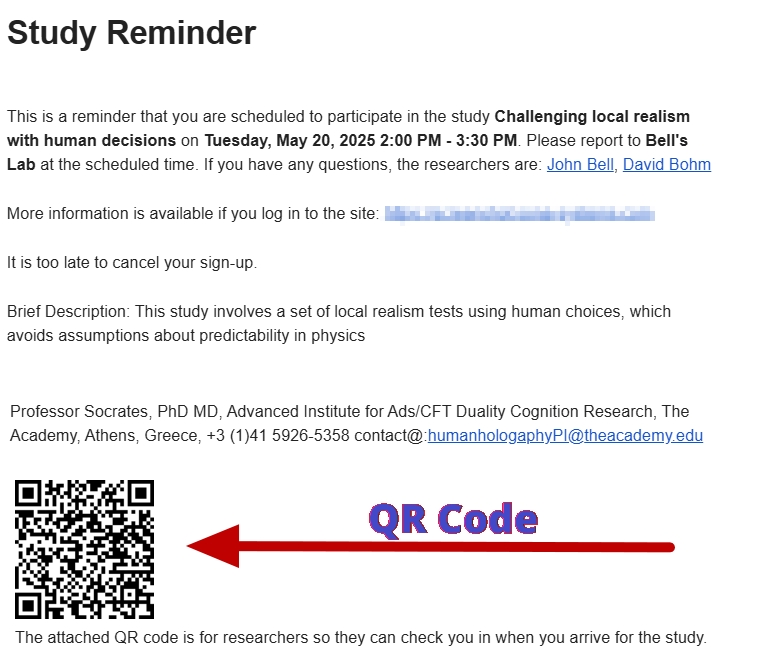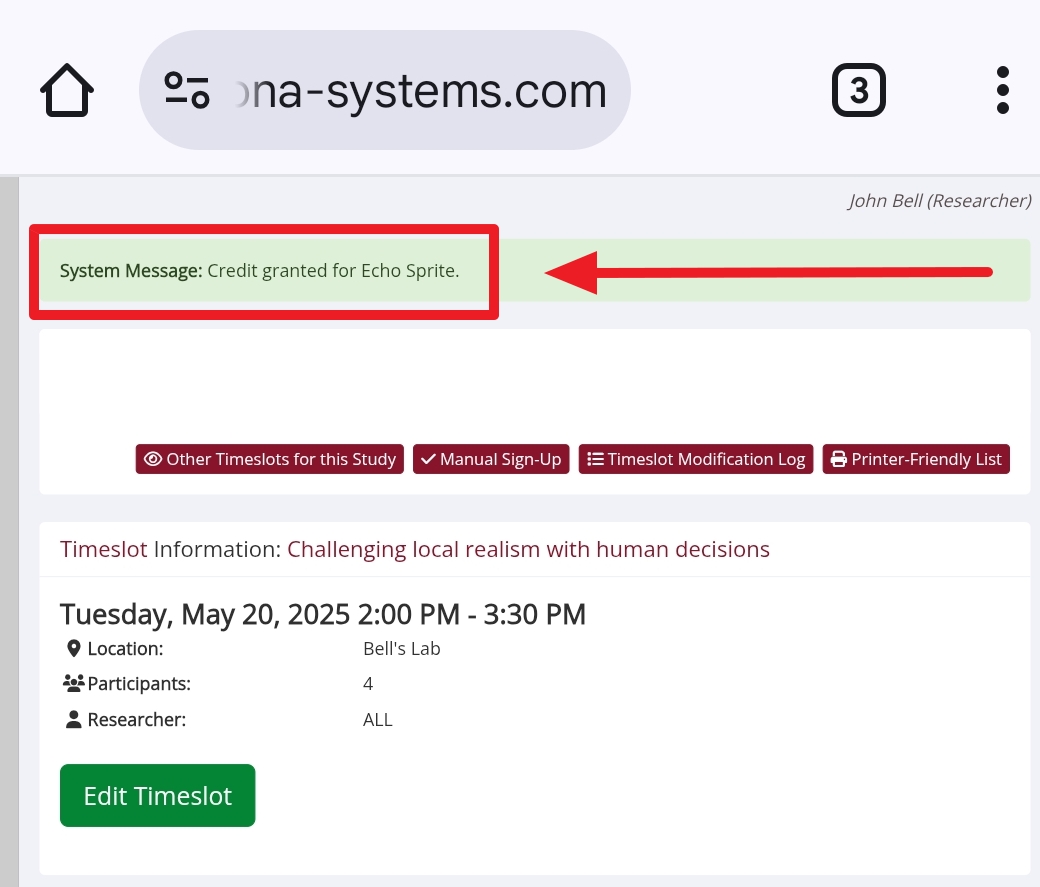Not your Typical Lab Scan
Sona has a QR Code feature that can greatly simplify life for both participants and researchers. Participants show-up to the lab, researchers scan the code, and that takes care of participation status! It’s quick, simple, and convenient.
Enabling QR Codes
QR codes make participation marking almost absurdly simple. The first step requires the administrator to enable this feature in System Settings:
When you set Automatic Reminder Email QR Codes to “Yes”, the system will automatically include a QR code in the reminder email sent to participants, providing that the reminder is for a lab study. These reminders are sent the day before timeslot date that the participant signed up for. If you haven’t already, you can set the time email reminders are sent out, including study reminders.
How it Works
The actual process is almost as easy as turning on the setting. Participants will continue to get reminder emails. Now, however, for lab/in-person and videoconference studies, this email will include a QR code at the bottom:
Participants can then show the researcher(s) the QR code from their email when they get to the lab (for studies using videoconferencing studies, participants can hold the QR code up to for scanning).
For researchers, it’s even simpler. The participant comes in, brings up the email on their mobile device, and the researcher can scan it using the sona mobile app or their phone’s camera (smartphone cameras typically come equipped with QR code recognition, but there are also many free apps available).
Although scanning from the screen is typically the easiest, participants can bring in a print-out of the email as well. Researchers can use the Sona app or built-in camera feature in this case too.
Once the QR code is scanned, it brings the researcher to their Sona account in the mobile app or browser, and then automatically grants credit/marks participation:
It’s that simple. Actually, it’s even simpler. The images and description needed to describe how the process works also make it seem more detailed. A more accurate description of the process, rather than how it works, would be something like this: Participants show up with their reminder email, Researchers scan their QR code, and credit granting/participation marking is taken care of.
Added Benefits
If it were just a matter of greater convenience, then we’d definitely still recommend using QR codes when possible. However, not everyone finds the same features as advantageous as the next. This is, perhaps, especially true for researchers who have been conducting studies a long time and already have a “tried and true” sign-in method for participants.
For researchers who are used to doing sign-ins a particular way, it’s not uncommon to hear some the tried and true argument that runs something like “what’s wrong with tried and true methods?”
Often, nothing is wrong with them. That doesn’t mean they’re optimal, either. And it doesn’t necessarily mean they’re best for researchers or participants! We can compare some more standard sign-in options to see why.
Signing in the the Standard Way(s)
A typical sign-in procedure would have participants coming into the lab to be greeted the researcher.
Often, they’ll have a printed list with today’s participants or even a certain timeslot’s participants. When the participant comes in, the researcher asks for a name, then places a check next to that name on the sign-in list.
Sometimes the names are in a spreadsheet or similar file on the computer. And there are other approaches or variations to these approaches, too. The researchers need know who showed up in order to mark participation, after all.
Privacy and Confidentiality Considerations
There are drawbacks to such approaches, however. A very important one relates to participant rights (in particular, those concerning confidentiality, privacy, etc.). A list of names clearly contains identifiable information. Even if it is only first names, such documentation must be carefully monitored not only to ensure it isn’t lost, but also to verify it’s destroyed as soon as possible.
The same issues apply to spreadsheets and other documents, including those saved on a computer. A list of names in a file is still a list of names that should be deleted as soon as possible.
There are, of course, alternative sign-in methods that take privacy and consideration into account. Administrators, for example, can set Participant Identification in System Settings to “Unique, System-Assigned ID Code”. If enabled, participants will bring their ID code whenever they sign-in and researchers can use a list with these instead of a list of names. With this Participant Identification setting enabled, the sign-in list becomes pre-de-identified.
Using that would take care of privacy and confidentiality concerns, certainly. But it’s worth pointing out that
- Researchers can still scan QR codes with Participant Identification set to “Unique, System-Assigned ID Code”
- and
- With any list, whether one with names or ID codes, researchers still need to access Sona and mark participation manually
The QR Code Way
Using the QR code way as your sign-in method for lab/in-person studies provides the best of both worlds. One doesn’t have to worry about a sign-in list with identifiable information, nor worry about marking participation from a list of deidentified system-assigned ID codes.
The sign-in process becomes a scan-in process that automatically grants credit/marks participation.
Final Notes and Recommedations
Offering QR codes by enabling Automatic Reminder Email QR Codes can definitely simplify the sign-in process. It allows researchers to meet, greet, & mark participation all at essentially the same time.
It does away with the need to have some sort of sign-in list so that names or ID codes can be marked off when participants come in.
It eliminates the need for researchers to use a sign-in sheet or list in order to mark participation or grant credit after they’ve spent hours doing back-to-back timeslot sessions. By extensions, it takes care of the not infrequent problem of researchers forgetting to mark participation.
Having A Back-up
What if participants forget to bring in the email?
This used to be a bigger concern. Now that QR code scanning capability is built into most mobile devices, a participant can “bring in” their QR code by bringing their phone with them.
It is still possible for participants to run into a problem during the QR code sign-in process. They may have a problem with the screen, or not know how to access their institutional email via their smartphone. Incidentally, this is one reason why Sona has a setting that allows participants to change their email account in Sona.
Even if all goes wrong, though, researchers can still mark participation manually. If they cannot scan the QR code, researchers can mark participation by accessing the timeslot for the study in Sona. Put differently, in the very worst case scenario, QR code scanning is…well, the regular sign-in process.
Researcher Consideration
Finally, researchers conducting particular types of studies or using particular study designs may wish to forgo (at least temporarily) the use of QR codes. For example, having an electronic device on one’s person is a safety hazard to a researcher conducting fMRI studies. Consequently, the researcher may store their phone in a safe location upon entering the lab.
With their phone safely stored away, QR code scans become considerably less convenient, particularly as the participants’ phones will need to be safely stored as well.
This doesn’t mean you will need to disable the Automatic Reminder Email QR Codes setting. Even though it is system-wide, the setting doesn’t prevent researchers from manually marking participation/granting credit if necessary.
Wrapping it up
QR codes are about as close as one can get to automatic credit granting for lab studies. Once participants can just show up and all researchers have to do is point their screens at the QR code, researchers and participants alike can enjoy some additional ease in all-too-complicated world.



